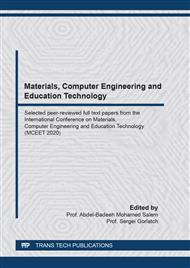[1]
JT Muth, DM Vogt, RL Truby, Y Mengüç, DB Kolesky, RJ Wood and JA Lewis, Embedded 3d printing of strain sensors within highly stretchable elastomers, Adv. Mater. 26(2014)6307-12.
DOI: 10.1002/adma.201400334
Google Scholar
[2]
L Paez, G Agarwal and J Paik, Design and analysis of a soft pneumatic actuator with origami shell reinforcement, Soft Robot. 3(2016)109-19.
DOI: 10.1089/soro.2016.0023
Google Scholar
[3]
P Wu, W Jiangbei and F Yanqiong, The structure, design, and closed-loop motion control of a differential drive soft robot, Soft Robot. 5(2018)71-80.
DOI: 10.1089/soro.2017.0042
Google Scholar
[4]
Zhou Youlin et al, Asymmetric structure based flexible strain sensor for simultaneous detection of various human joint motions, ACS Appl.Electron Mater 1(2019)1866-1872.
DOI: 10.1021/acsaelm.9b00386
Google Scholar
[5]
Chen Shuai, Lou Zheng, Chen Di, Chen Zhaojun, Jiang Kai and Shen Guozhen, Highly flexible strain sensor based on zno nanowires and p(vdf-trfe) fibers for wearable electronic device, Sci. China-Mater. 59(2016)173-181.
DOI: 10.1007/s40843-016-0128-8
Google Scholar
[6]
DH Kim, JH Ahn, WM Choi, HS Kim, TH Kim, J Song, YY Huang, Z Liu, C Lu and JA Rogers, Stretchable and foldable silicon integrated circuits, Science .320(2008)507-11.
DOI: 10.1126/science.1154367
Google Scholar
[7]
T Yamada, Y Hayamizu, Y Yamamoto and Y Yomogida, A stretchable carbon nanotube strain sensor for human-motion detection, Nat. Nanotechnol. 6(2011)296-301.
DOI: 10.1038/nnano.2011.36
Google Scholar
[8]
TW Shyr, JW Shie, CH Jiang and JJ Li, A textile-based wearable sensing device designed for monitoring the flexion angle of elbow and knee movements Sensors .14(2014)4050-9.
DOI: 10.3390/s140304050
Google Scholar
[9]
JJ Park, WJ Hyun, SC Mun, YT Park and OO Park, Highly stretchable and wearable graphene strain sensors with controllable sensitivity for human motion monitoring, ACS Appl. Mater. Interfaces .7(2015)6317-24.
DOI: 10.1021/acsami.5b00695
Google Scholar
[10]
F Xu and Y Zhu, Highly conductive and stretchable silver nanowire conductors, Adv. Mater. 24(2012)5117-22.
DOI: 10.1002/adma.201201886
Google Scholar
[11]
Eve Verpoorten,Giulia Massaglia, Gianluca Ciardelli, Candido Fabrizio Pirri and Marzia Quaglio, Design and optimization of piezoresistive peo/pedot:pss electrospun nanofibers for wearable flex sensors, Nanomaterials.10(2020)2166.
DOI: 10.3390/nano10112166
Google Scholar
[12]
Maharjan, Pukar, et al, A human skin-inspired self-powered flex sensor with thermally embossed microstructured triboelectric layers for sign language interpretation. Nano Energy 76(2020)105071.
DOI: 10.1016/j.nanoen.2020.105071
Google Scholar
[13]
Peng Jun, Flexible stretchable strain sensor based on silver nanowires and multi-wall carbon nanotubes (In Chinese), Diss. (2019).
Google Scholar
[14]
Zhou, Lu Yu, Gao, Qing, Zhan and Jun Fu, et al, Three-dimensional printed wearable sensors with liquid metals for detecting the pose of snakelike soft robots, ACS Applied Materials & Interfaces. (2018).
DOI: 10.1021/acsami.8b06903
Google Scholar


